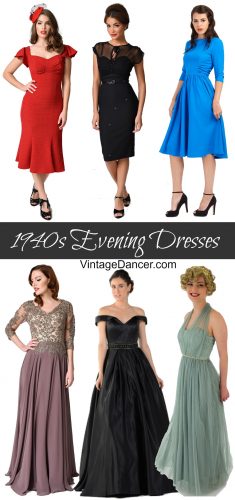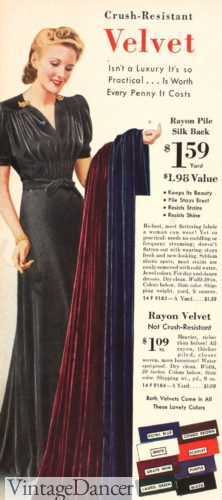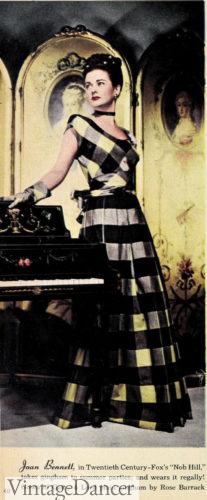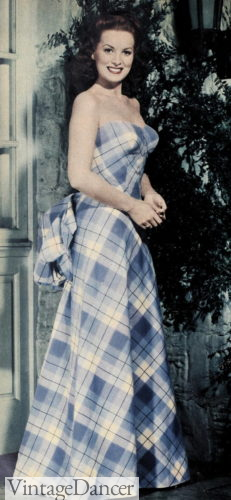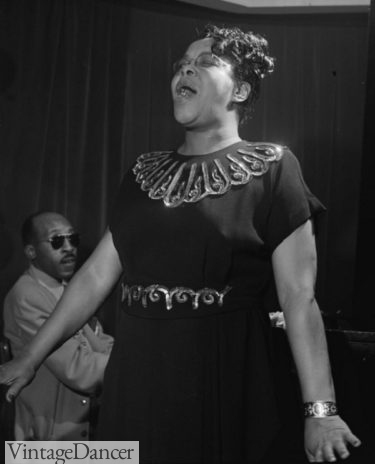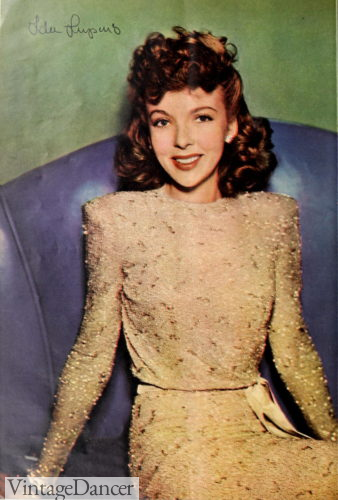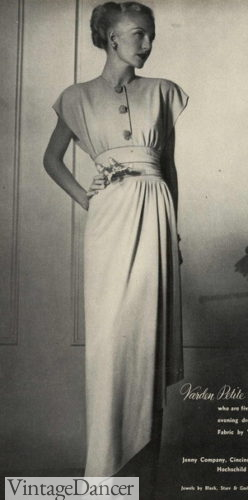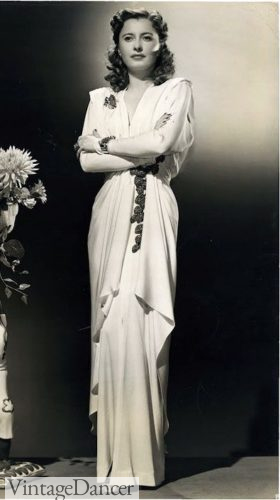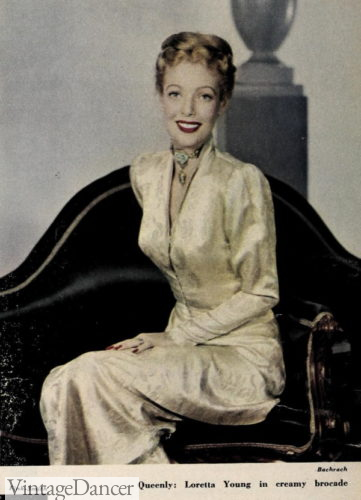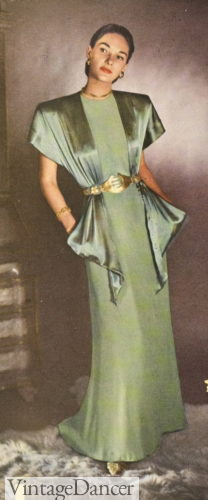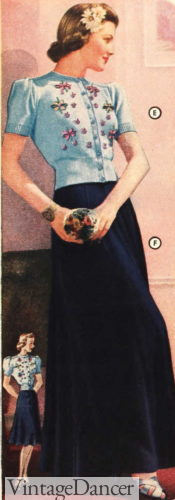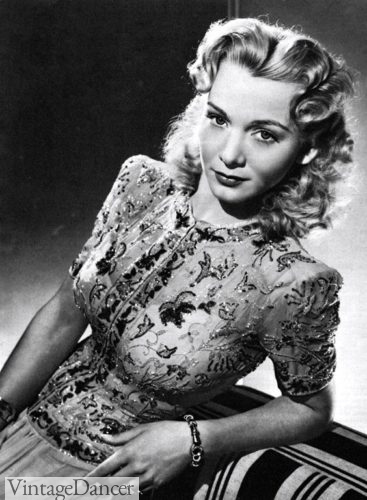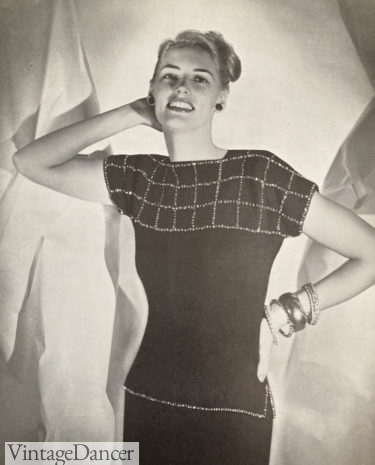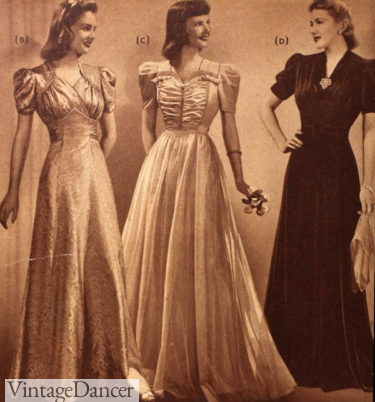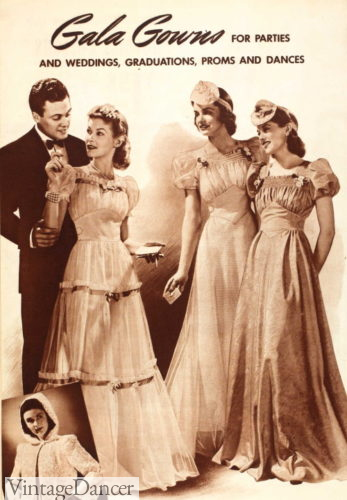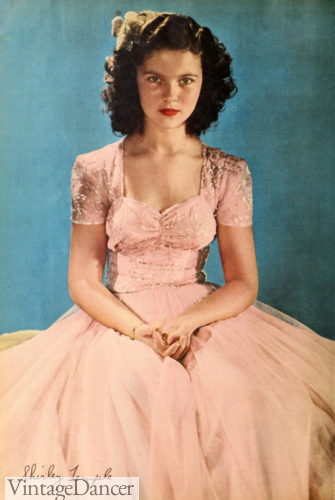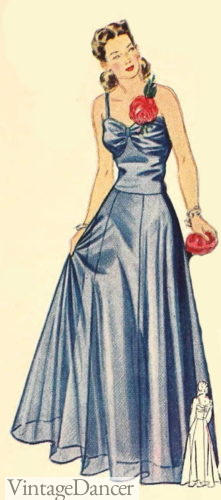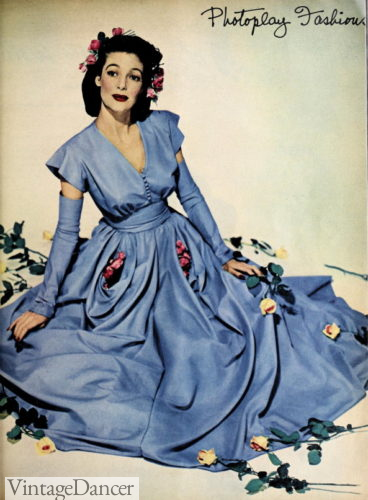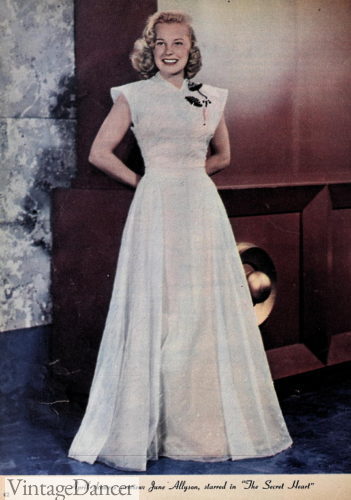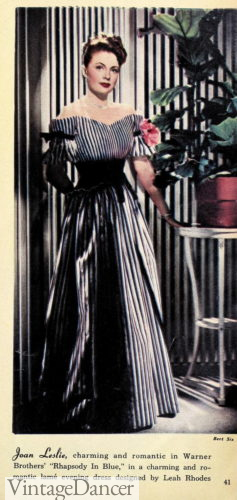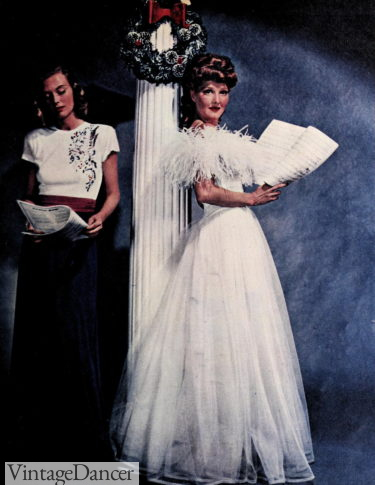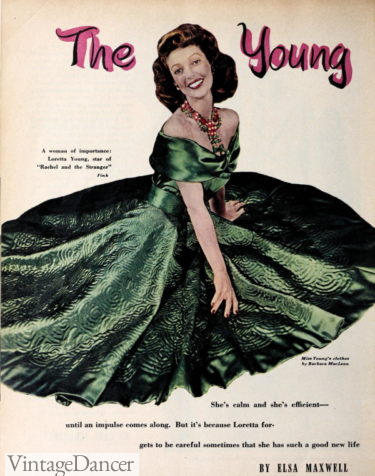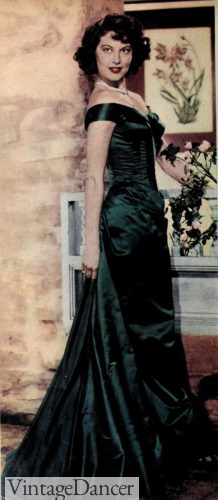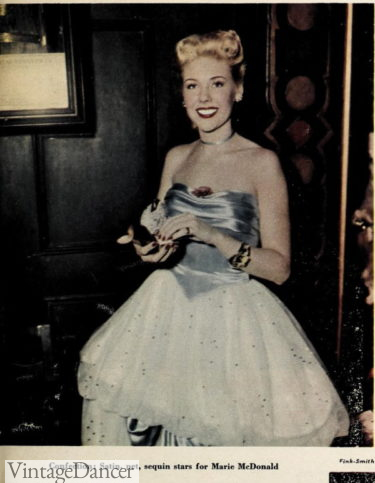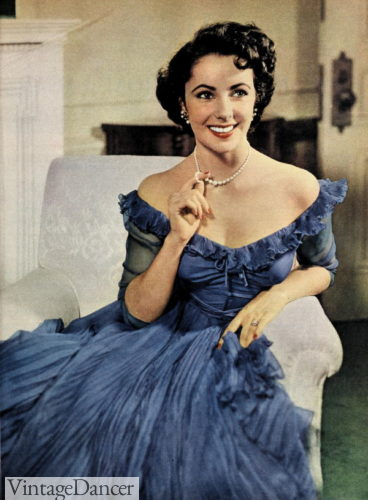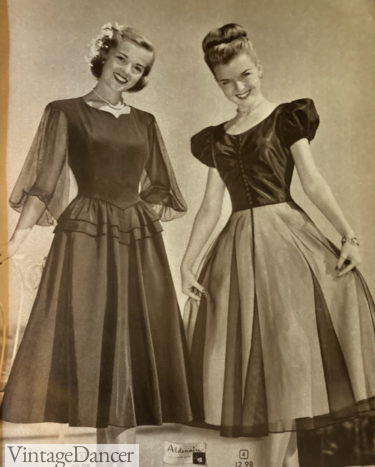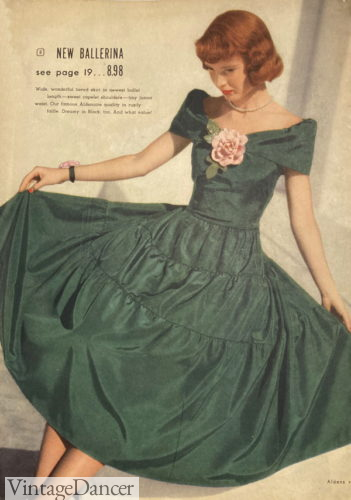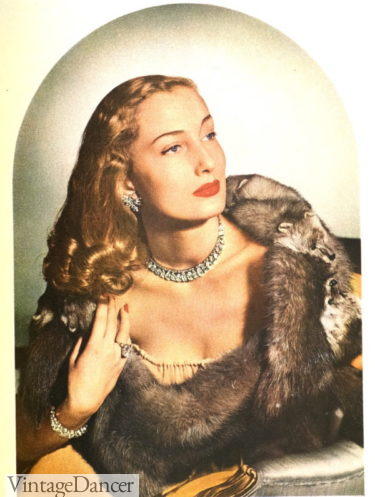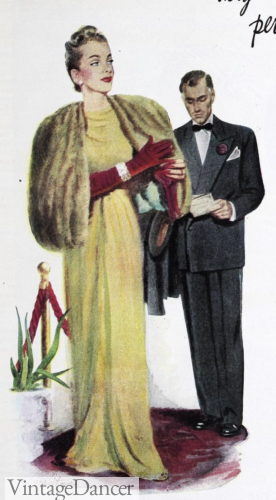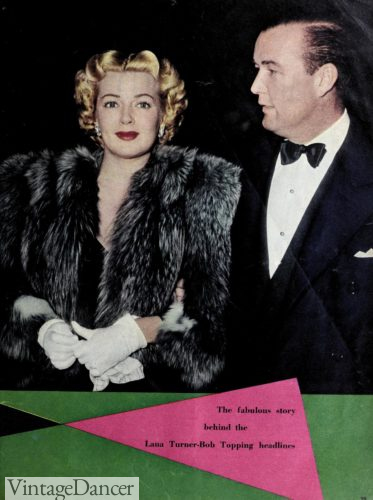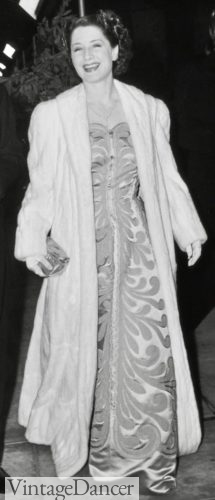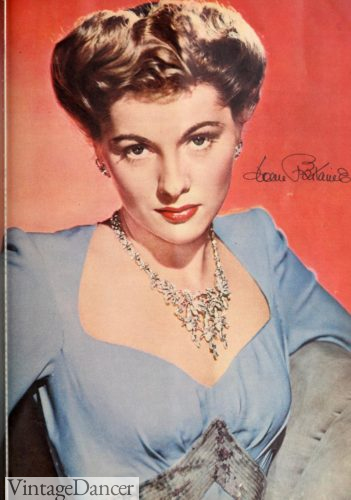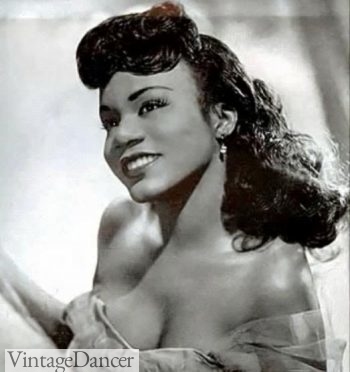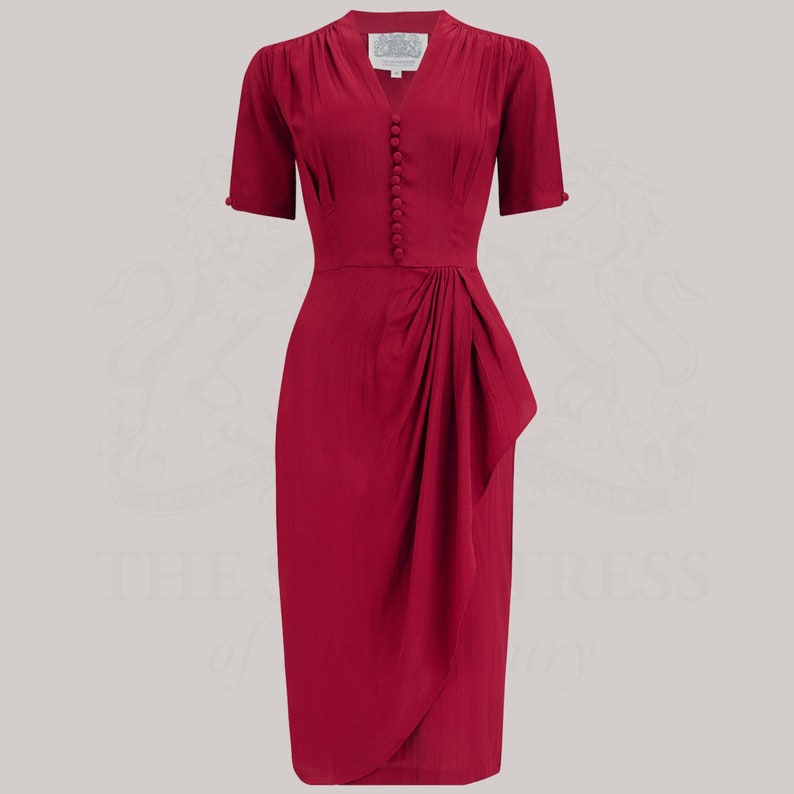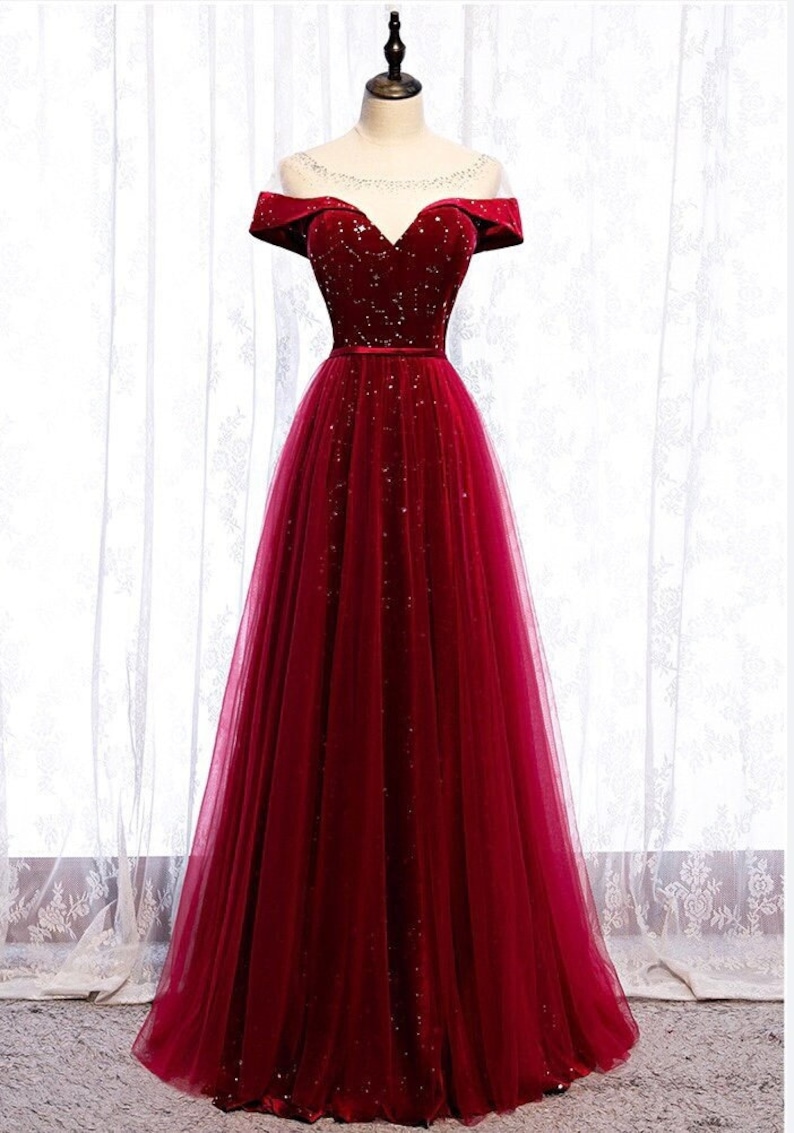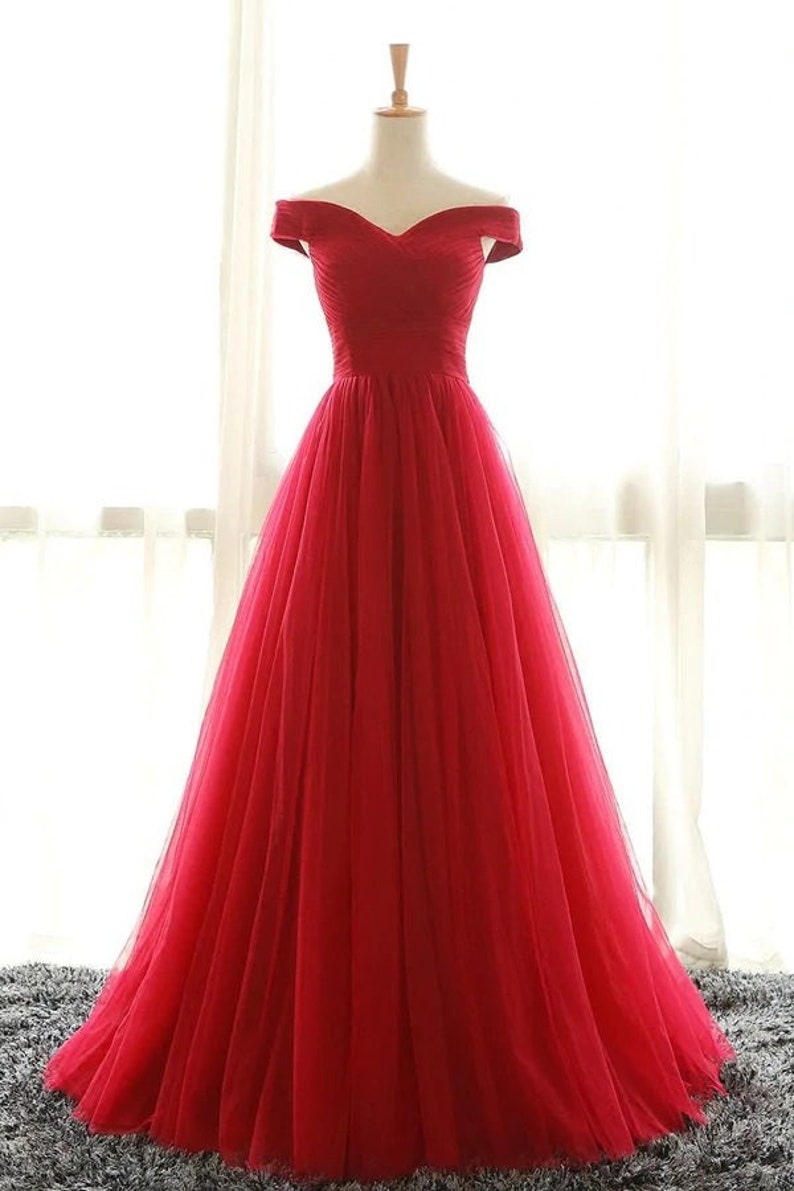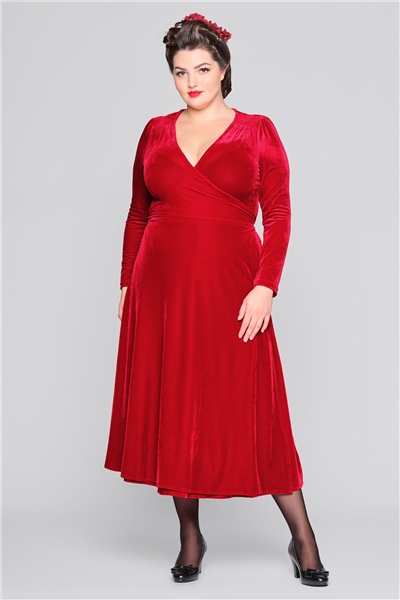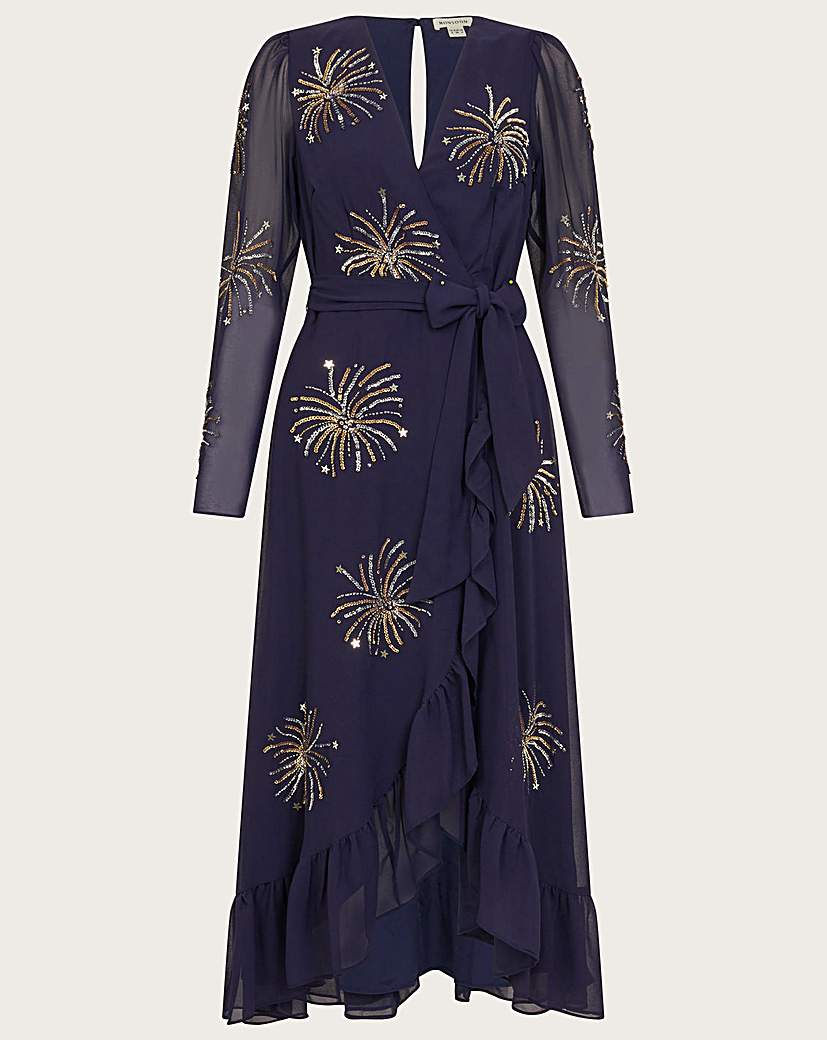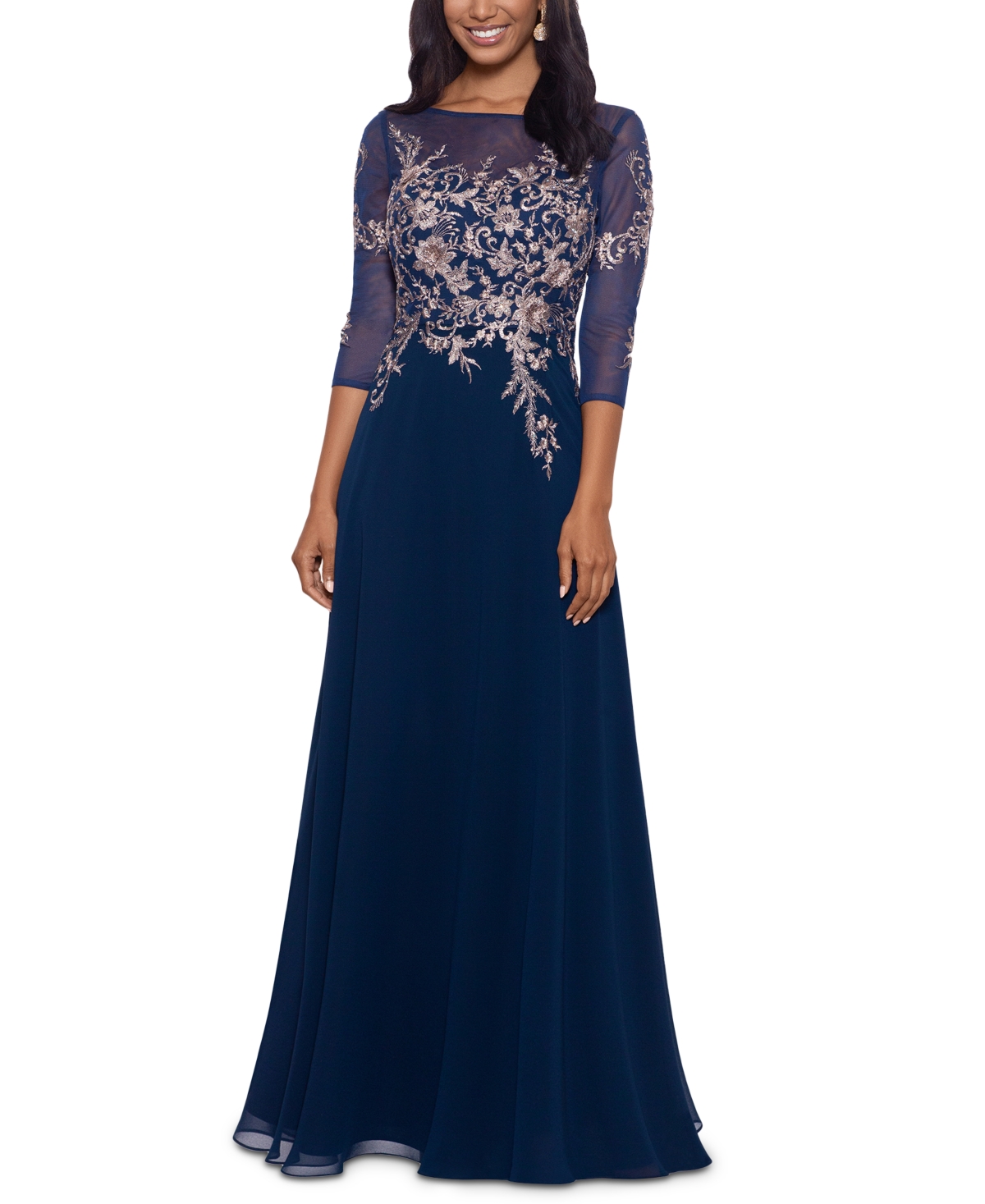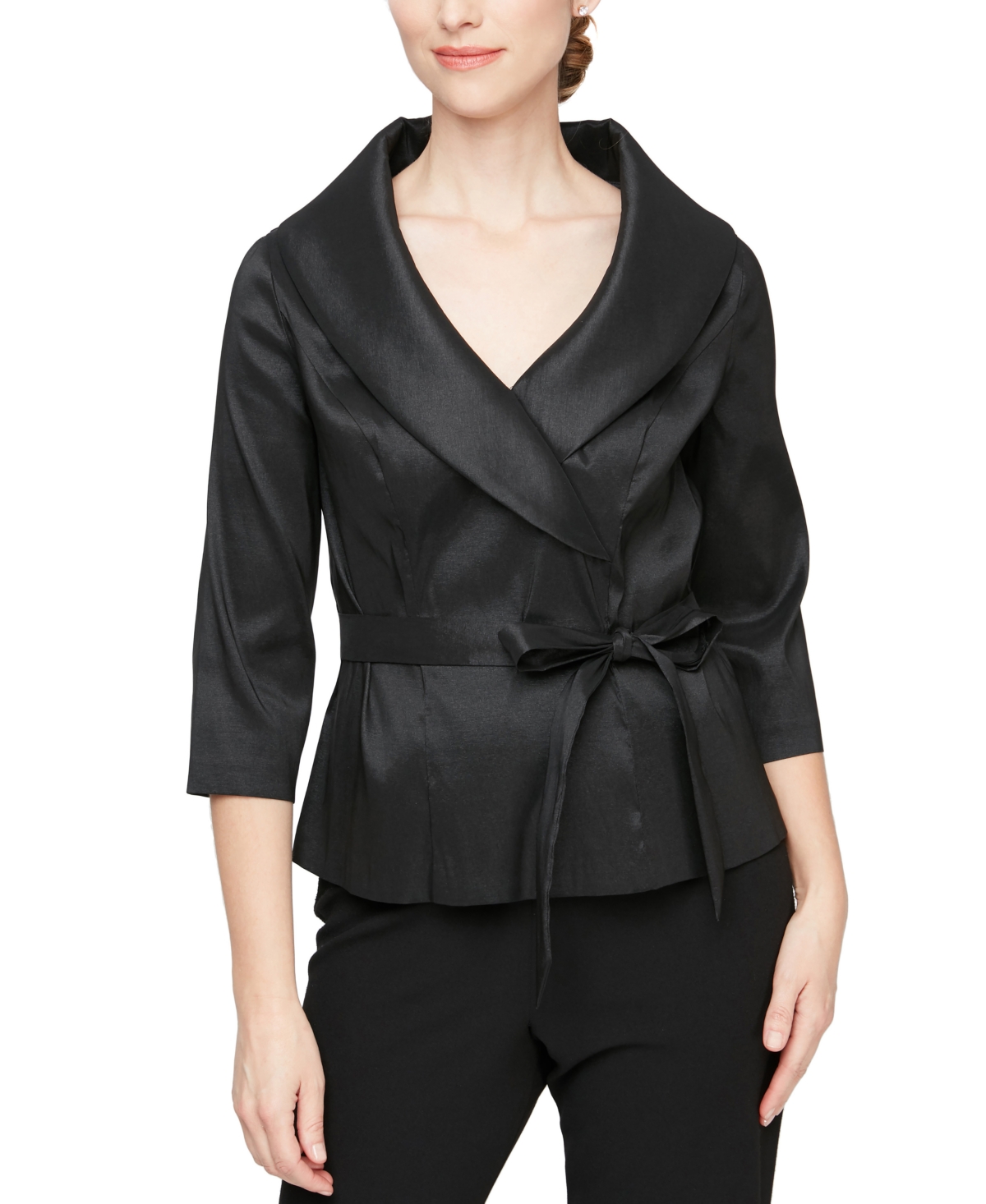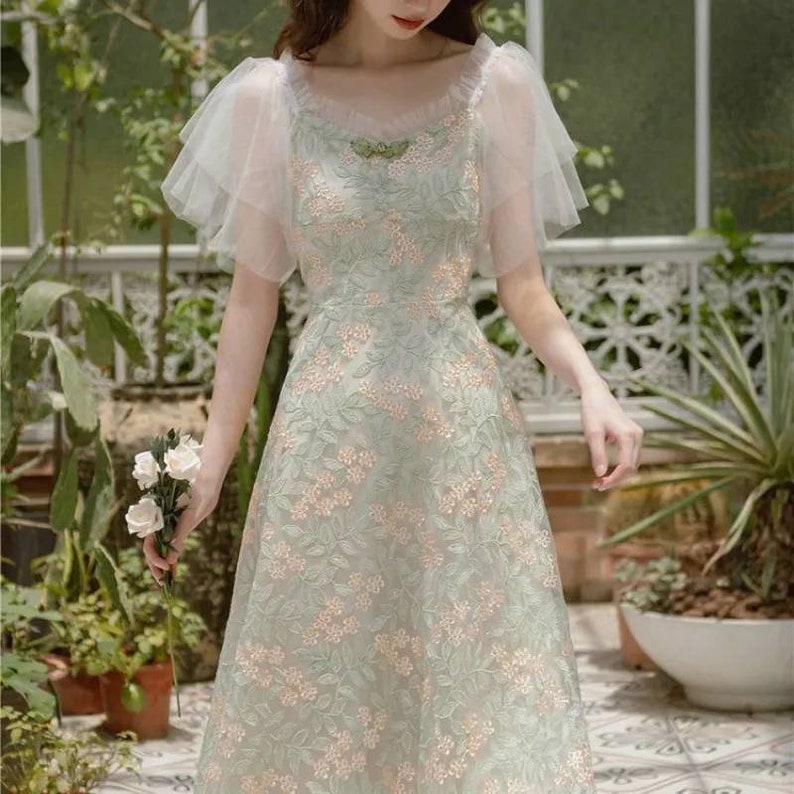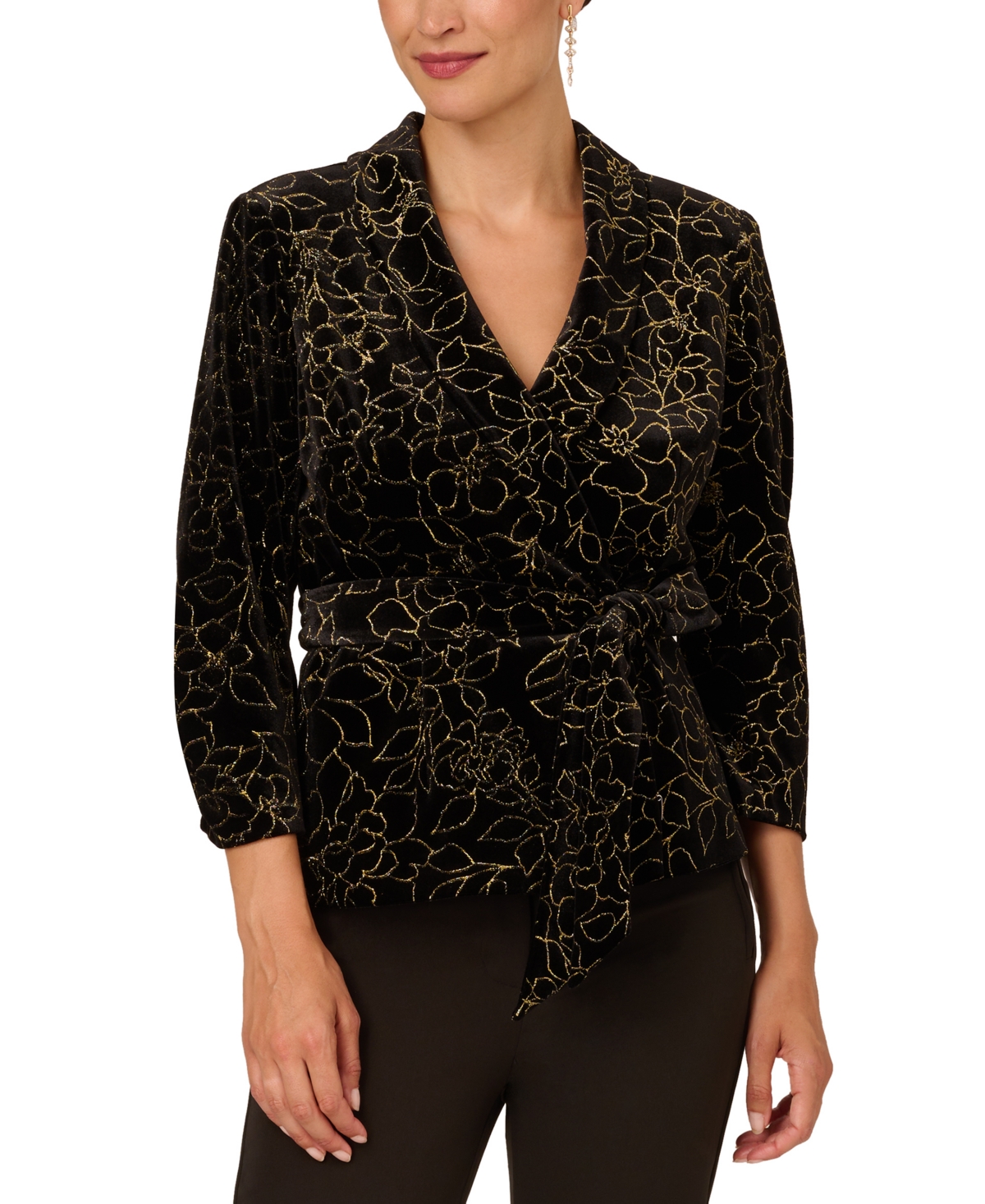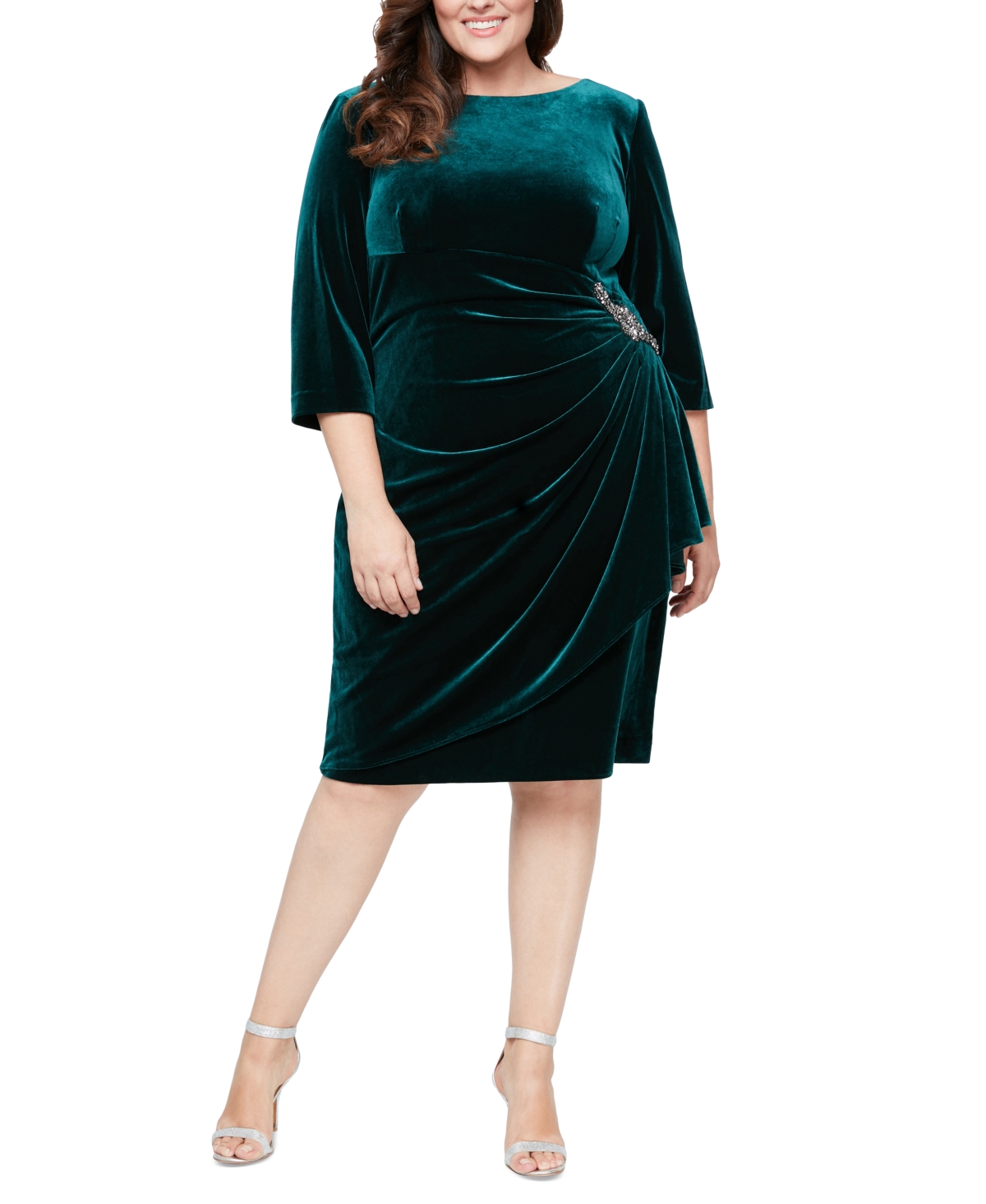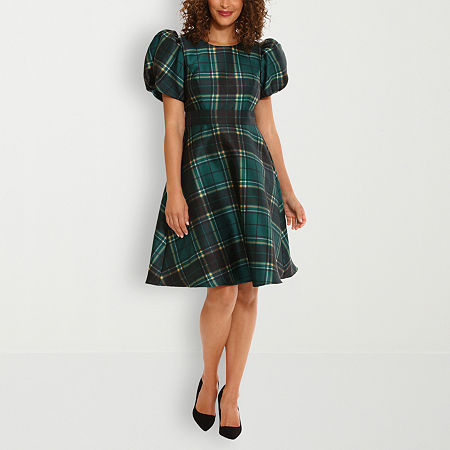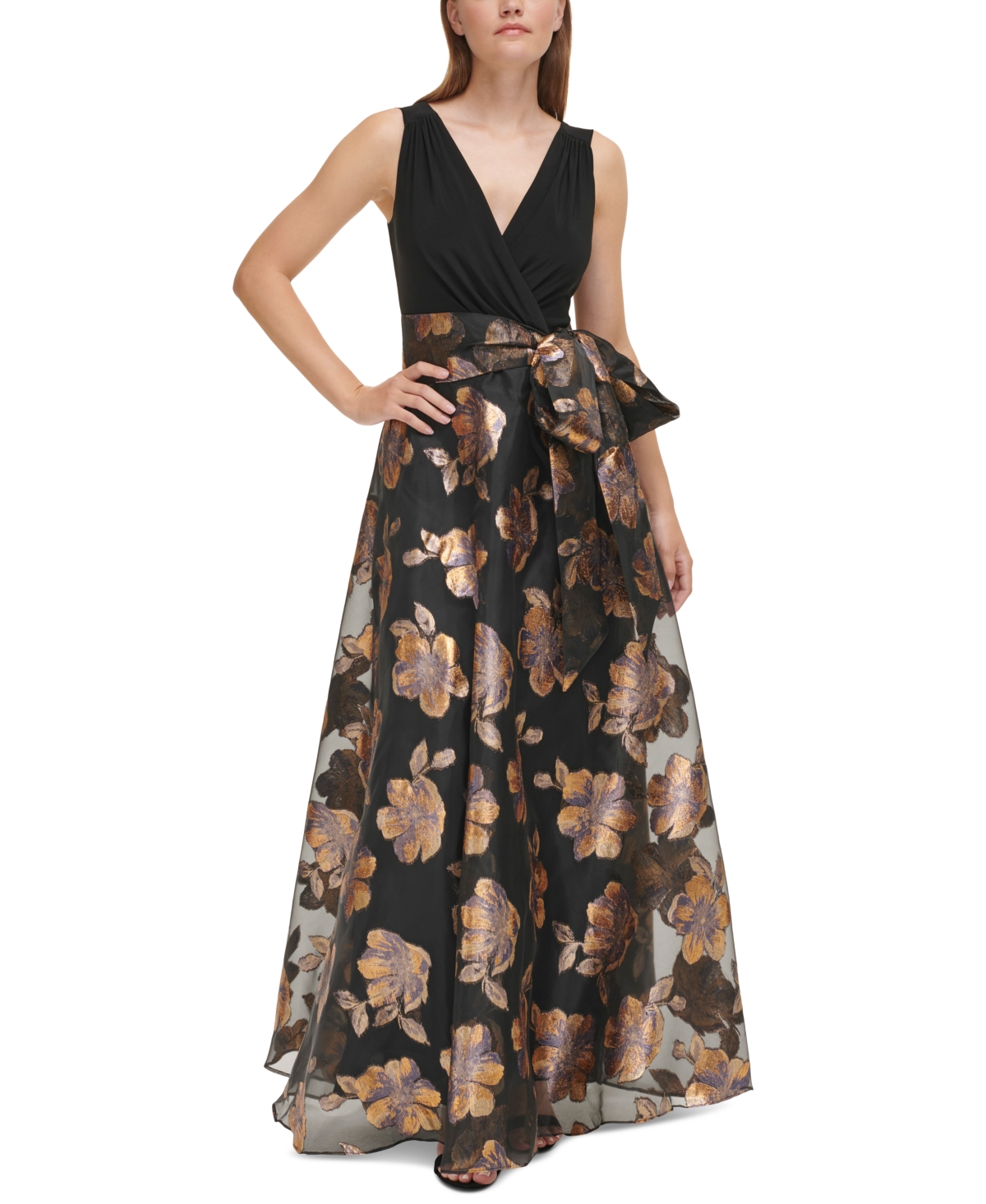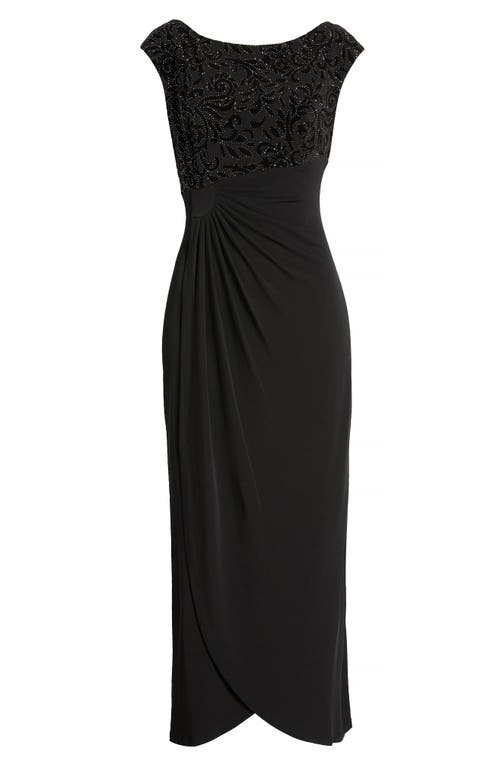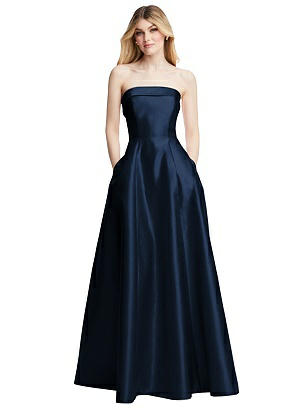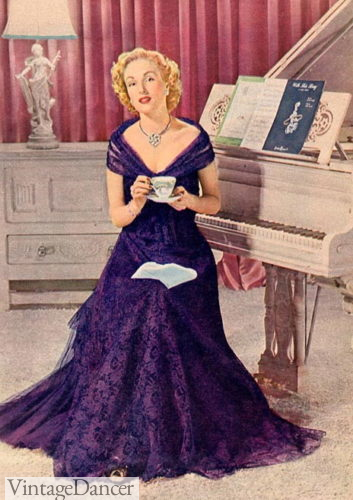
1949 purple evening gown
1930s formal gowns were long, sleek, and sexy – the basis for most modern formal wear today. The 1940s formal dresses moved away from the bias cut gown in favor of the Grecian column or ballgown shape. With every year the ballgown skirt grew bigger and fuller and bodices shrunk, mimicking those from the Victorian era.
For an elegant nighttime event, choosing a 1940s evening gown and accessories, whether genuine vintage or new vintage inspired begins with a little history.
Ready to shop? Skip over to our page of 1940s style gowns you can buy now.
1940s Evening Gown Fabrics and Colors
1940s formal dresses were often made from rayon taking the form of jersey, taffeta, damask, satin and velvet. Some gowns were even made from cotton or a cotton blend making them affordable to all.
Sheer fabric came into 1940s eveningwear designs when the new ballgown shape replaced the Grecian styles. Sheer organdy, chiffon, net, tulle, and marquisette helped make these gowns as light as air.
Heavier fabrics were needed in the late 40s when ballgowns contained structured bodices and full Victorian era skirts.
- 1940 rayon velvet fabric
- 1944 velvet, sheer nets, bengaline fabrics
Evening gown colors in the early years favored white (not just for weddings!), rose pink, light blue, and aqua blue.
The middle year brought in jewel tones of wine red, royal blue, black, scarlet red, emerald green in fall as well as saturated yellow, pink and aqua green for summer.
The final years wore all colors but newest to the line were deep purple, silver and several shades of green ranging from dark hunter to a bright chartreuse.
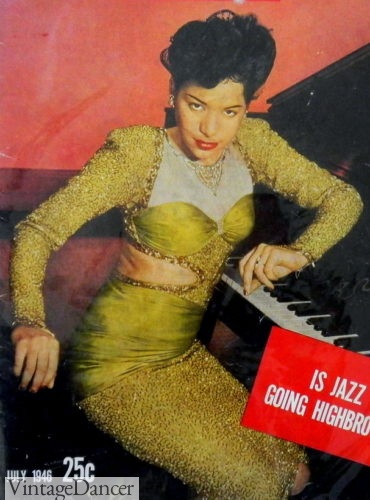
1946 a fabulous beaded chartreuse green gown
While most evening gowns in the 20th century were solid colors with matching trim the 1940s played with some patterns. Floral prints were common in the summer in the early years. Plaid became a major hit in the middle years- large black, silver or blue plaid prints were bold and unexpected. Vertical stripes were trendy as well. Patterns, however, were short lived as formalwear went back to solids going into the 1950s.
- 1945 black plaid evening gown
- 1948 blue plaid ballgown
1940s dinner dresses and gowns were simple but shiny and did tend to be more on the casual side than anything in the decades before or after. What made eveningwear formal in the early 1940s was the use of decoration. Sequins, applique and beads were not rationed or restricted and were used to embellish dress bodices, jackets and sweaters. They added sparkle while keeping costs down. Of course, the very rich could afford an a fully beaded and sequined evening gown but middle classes kept the decoration to a minimum.
- 1946 sequin trim gown worn by Bertha Chippie Hill
- 1942 all over bead and sequin column gown- very expensive!
After the war, as women’s 1940s formalwear favored solid colors and heavy fabrics, embellishment on evening dresses were not necessary. However accessories grew bigger and bolder adding drama in a different way. More on those further in the article.
Early 1940s Formal Dresses
The economy still wasn’t very good, so the early 1940s compromised by continuing some of the 1930s style- Column gowns and Grecian wraps- with iconic 40s puff sleeves and an hourglass waistline. The result is classic, pretty, and simple 1940s formal gowns and evening dresses that teens wore to prom and women wore out to a fancy dinner with dancing.
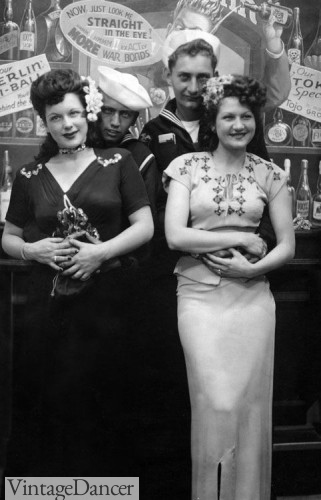
Girls out for a night with their sailor men wearing long dresses form the 1930s and early 40s.
The Grecian Gown
The Grecian style gown was a tall vertical or column silhouette with draping around the waist and hips. 1940s Grecian gowns were worn to dinner parties and formal affairs that did not have dancing. Many had embellished buttons or applique to add sparkle while remaining simple. They all had pointy shoulder pads that lent to a strong statuesque figure. Black, gold or silver belts frequently accent the waistline.
The Grecian draped gown gave way to the slender column gown in the late 1940s. They lacked any draping around the hips although gathers around the bust were common.
- 1945 Grecian gown with draped wrap skirt
- 1941 Barbara Stanwyck Grecian draped gown
- 1948 gold brocade Column gown – Loretta Young
- 1947 green goddess gown with gold belt
- 1945 Grecian gown with draped wrap skirt
- 1941 Barbara Stanwyck Grecian draped gown
- 1948 gold brocade Column gown – Loretta Young
- 1947 green goddess gown with gold belt
1940s Formal Gown and Jacket
One evening look during the ’40s was the long column gown and dinner jacket. A dinner jacket, fitted and usually short (to the waist), was worn on top of the dress.
The dinner jacket was decorated with sequins and beads, either all over or down the front, and had square shoulder pads. Buttons on dinner jackets were often decorated themselves with beads or rhinestones.
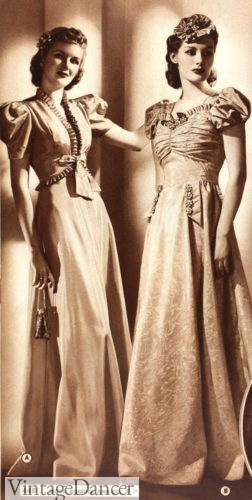
1940 short jacket over a dress
A bolero jacket was also worn as a dinner jacket. These were short, coming only to the waist, with rounded edges at the front. They would have similar decorations and would close with a button at the top or middle or could be left open.
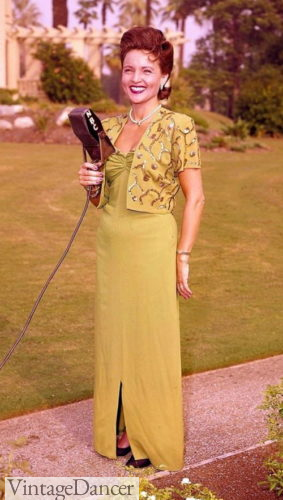
Late 1940s Betty White’s green gown with jacket
1940s Evening Skirts and Tops
In the early 1940s and again around 1948 there was a trend for pairing long ballgown skirts with a fancy blouse or embellished sweater or jacket. This look was affordable to most because the blouse could be worn again during the day. Even the long skirts could be shortened and reused again.
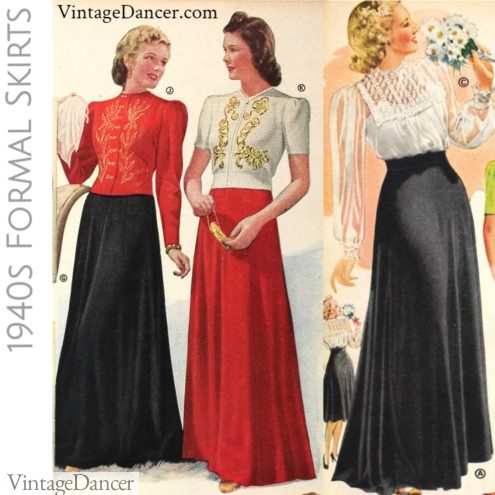
1940-1941 skirt and pretty tops
Lace blouses with sheer sleeves, silky blouses, and peplum blouses in white, ivory or other light color (pink, blue) as well as floral prints were all welcome tops to pair with floor length A-line skirts in solid black, red, or navy blue.
Another pretty option was the short sleeve sweater, cardigan or jacket with embellishments of gold sequins, beads, rhinestones and applique.
- 1940 long skirt
- 1940 Blouses
- 1941 sequin trimmed short sleeve jacket
- 1947 rhinestone trimmed sweater dress
Long skirts with pretty tops make an excellent alternative to dresses for a 1940s formal affair. I have found that formal long skirts are more difficult to buy in stores. Sometimes I take a thrifted ballgown with a too modern top and cuff off the skirt, add a waistband and pair it with a pretty blouse.
For ready made skirts, some will be include in 1940s style skirts but also look at Victorian/ Edwardian skirts for even more floor length options.
The Victorian Ballgown
In 1939, Gone with the Wind came to theaters with amazing success. Suddenly, fashion turned back in time to the Victorian age, especially formal gowns and dresses, which embraced fitted bodices, puffed sleeves, and large full skirts- perfect for waltzing!
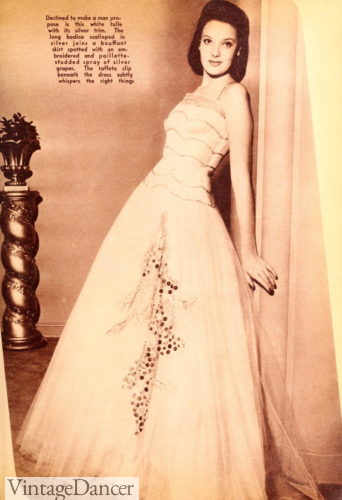
1941 silver trimmed white tulle ballgown
Made of light fabrics and in light springtime colors (white, pink, light blue) or rich velvet in wintertime- the gowns were the opposite of the 1930s bias cut or 1940s Grecian style.
The ballgowns were youthful and innocent- ideal for young teens and women to wear to formal dances or as bridesmaids. Some gowns were trimmed in ribbons, lace, small bows and flowers for even more girlish delight. Coordinating hats were also sold with spring gowns.
- 1941
- 1942
The princess ballgown was the most popular style for teens attending a prom. The prom dance was a relatively new invention in the late ’30s and ’40s, and teens made extra effort to wear their best dresses to the dance.
Here’s a video showing 1946 teen fashion at a prom or party (and dating tips too):
In the middle 40s the puff sleeve ballgown simplified into a short sleeve or narrow strap bodice with sweetheart neckline. The skirt was still wide enough for dancing.
- 1942 pink ballgown worn by Shirly Temple
- 1944 a simple blue narrow strap evening gown with waltz with skirt
- 1946 blue ballgown
- 1948 white ballgown
The Victorian ballgown or princess ballgown once again went into a new direction when straps came off. The off the shoulder strapless bodice with larger and fuller skirt echoed the early Victorian era. They were oh so glamorous. Many fashion designers designed dramatic evening gowns for dancing scenes in the movies and red carpet walks.
The very full skirt of the Victorian age was reduced to long, semi full A-line skirts in the 1940s. A petticoat was worn underneath to add fullness, otherwise skirts were simply cut wide, pleated at the waist, or layered in tulle. Later in the 1950s, skirts shortened and expanded even wider with the use of multiple petticoats and hoop skirts.
- 1945 Lame striped gown
- 1945 dinner dress and ballgown
- 1947 green off the shoulder gown
- 1947 satin Edwardian inspired gown
- 1948 strapless ballgown made of satin, net and star sequins
- 1949 Elizabeth Tailor blue ballgown evening princess off the shoulder
The ballerina bodice revealed more upper chest, neck, and shoulders than most 1930s gowns. These required women to wear strapless bras and bra/girdle combinations with low backs. Many dresses featured drop sleeves hung around the shoulders, which was a common style among Victorian ballgowns.
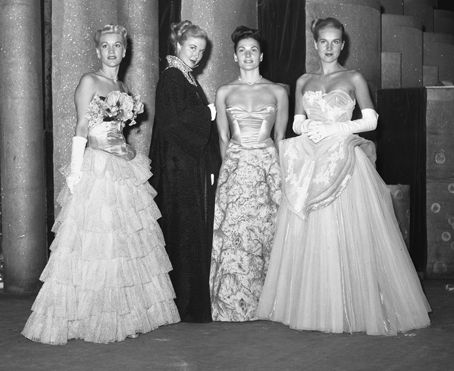
Princess Ballgowns- 1947 dresses inspired by Victorian Ballgowns
1940s video about 1940s formal gowns:
The Ballerina Gown
In the late 1940s the ballgown silhouette shorted up to the new Ballerina length. These fun midi length dresses explores legs and shoes, much like cocktail length dresses did, but were formal enough for a ball. The youthful look was embraced first by teens and young women but it wasn’t long before all women were wearing party dresses in the new length.
- 1948 sheer Ballerina dresses
- 1948 taffeta ballerina dress
1940s Evening Dress Accessories
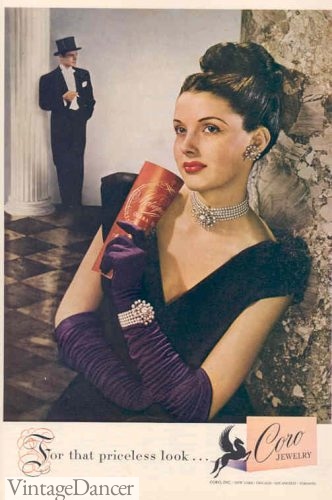
1946, rhinestone and pearl choker necklace and large bracelet
Gloves
The beauty of 1940s formal dresses was all that was needed for a night out. Many women did choose to accessorize their gowns with long black or white ruched gloves. They reached up to the elbow but not over the elbow until closer to the 1950s.
Colored gloves were also trendy for a time- usually a very bright color in contrast to the dress color. Shop vintage style gloves for your outfit.
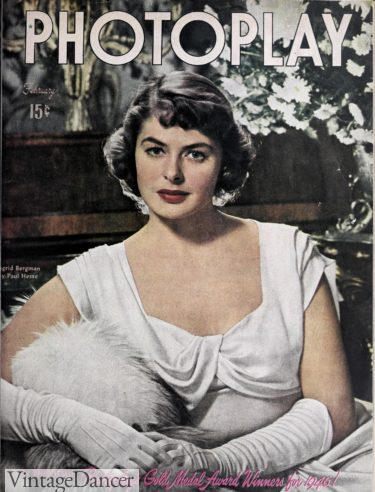
1948 matching long gloves
Glove etiquette says gloves should remain on unless eating, drinking or using the restroom but by the 1940s these old rules were fading away. Women would wear gloves into an event or for pictures but quickly took them off at the event.
A small pouch bag with drawstring handles was the most “Victorian” evening bag. They looked well with ballgowns but out of place with column gowns. Shop Victorian pouch bags here.
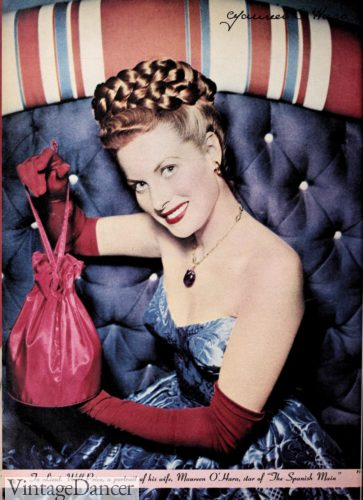
1945 braided updo and drawstring bag with Maureen O’Hara
Flat clutch bags were a more practical purse to carry and worked with any outfit.
Small evening purses were made of satin, silky rayon, or rayon velvet in a color to match an outfit or black or white. Sparkling brocade and black felt with a glint clasp were also common evening purse designs.
Read more about the history of women’s 1940s evening handbags.
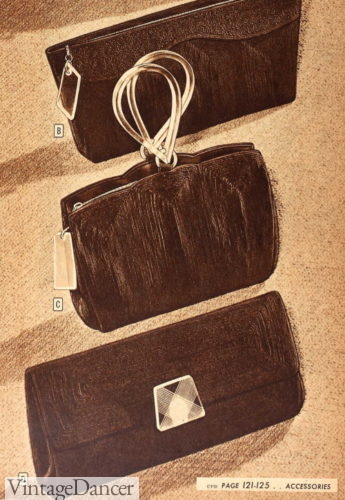
1944 corded rayon purses with Lucite pulls or clasp
Furs and Coats
To keep warm, a fur stole was frequently seen on movie stars and in high-end fashion magazines. On the whole, adding furs to an evening dress for the average woman was seen as too ostentatious.
Wearing a fur coat or cape to and from an event was an acceptable way to keep warm in a very glamorous way.
- 1947 fur stole, long hair, jewelry
- 1947 fur cape
- 1947 short fur box coat
- 1940 long fur coat
1940s Evening Jewelry
Jewelry was minimal during the day but dramatic in the evenings. Large rhinestone, gold or crystal bib necklaces were the focal point of low neck gowns. Equally large clip on earrings were round-ish in shape. Rings too were large and sparkling. One or several bracelets were worn over gloves.
A high neck beaded, pearl or rhinestone necklace in single or multiple stands was the most popular. A pair of sparkling earrings was a must, although the design should not overpower the dress. Some semi formal or cocktail dresses may have had a fancy brooch worn instead of a necklace. Learn more here.
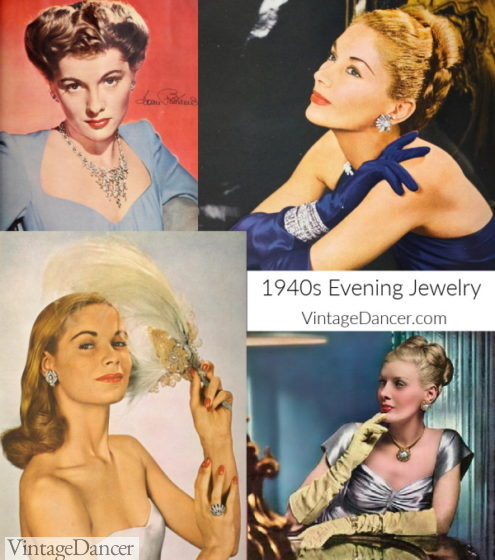
1940s evening jewelry
For the less wealthy, women may have worn their pearls. Pearl earrings, a single or multi strap pearl necklaces, and pearl bracelet. However with cheap costume jewelry becoming more affordable after the war, most women were glad to buy something new for the occasion.
1940s Evening Stockings
Nude or black? What color stockings should a woman wear with her formal dress? Black was more common with most colors except the very light ones. Nude stockings were also worn with any color for dress. Since gowns were long, stocking were not usually visible.
Stockings in 1940s still had a seam down the back of the leg and a reinforced heel. Nude stockings had nude matching seams. The more sheer the stocking the more appropriate for evening wear. It didn’t matter if the seam were visible when wearing peep toe or sandal heels. Learn more about 1940s stockings and buy backseam stockings.
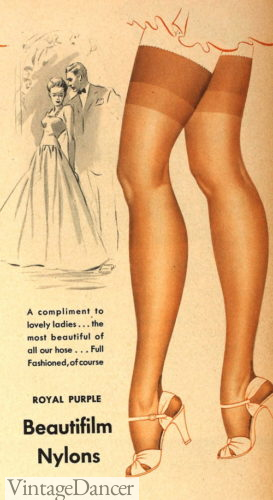
1942 fine stockings, nude with heel
Since stockings were thigh high and held up with garters the question of what to wear for lingerie is an important one. In the 1940s most women would have worn a full All-In-One corselet (bra and girdle one piece combination) that smooths the body from bust to thigh. Read more about 1940s lingerie.
Today we have body shapewear and tummy control nylons (Hello Spanx) to achieve a similar smoothing effect. Feel free to use these if you wish or go for some vintage reproduction lingerie for a more authentic shape.
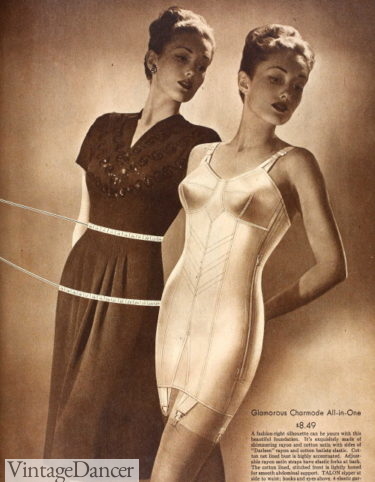
1946 All In One for formalwear
1940s Evening Shoes
1940s evening shoes were usually 2 1/2 inch high heel sandals, without straps or ornamentation of the toe box. Straps were often ankle straps to keep them securely on the feet. Peep toes were very common, exposing only a bit of one toe not an entire open toe like most modern evening shoes have.
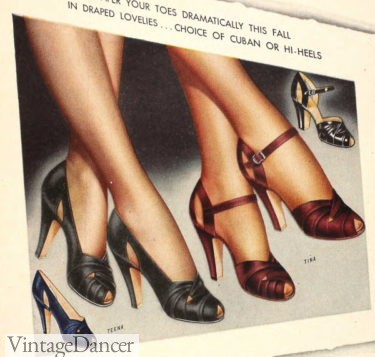
1940 dressy heels
Black was the standard color, although a light color dress would need white shoes. Heels were a bit thinner than daytime shoes featuring Cuban or high heels.
For women who did not like high heels there were low heel shoes with a dressy look. Shiny patent leather or velvet were the best materials.
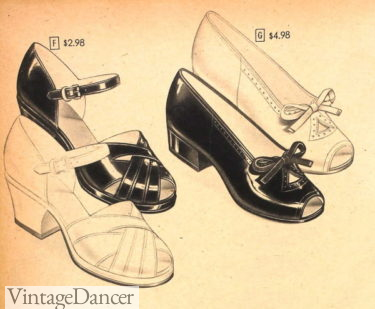
1948 low heel dancing sandals and bow trim peep toe pumps
Long dresses usually touched the floor hiding any evidence of shoes altogether.
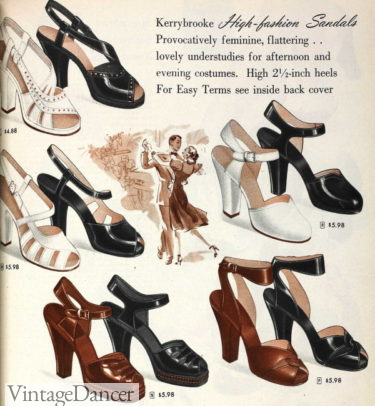
1947 sandal heels
In the late 40s shoes were loosing weight and slimming down. Heels with thinner and higher, straps were thinner, and box boxes exposing some toes.
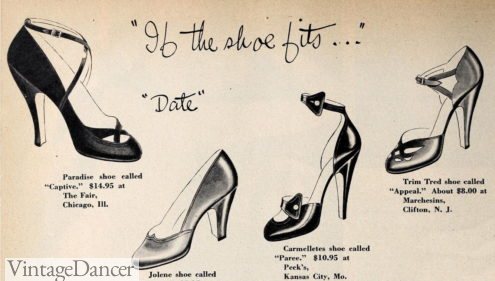
1949 evening shoes
Hair and Makeup
1940s Makeup – Evening makeup wasn’t too different than daytime looks. Eye shadow was added to a daytime look with heavier application of mascara and brighter, bolder red lips.
1940s Hairstyles – Evening hairdos were up, up and away. Braided crowns and buns were the best for long hair. A few glamorous stars wore long hair down in waves and loose curls. Some had a center part while others, a deep side part.
- 1942 jewelry
- 1942 roses
- 1947 fur stole, long hair, jewelry
- Long curly African-American hair
The poodle (a big pile of curls on top) was another good choice for medium length curly hair.
Short hair was styles in rolls and waves pulling hair towards the back of the head. Or it was styled curly but neat.
A high braided bun or crown was elegant for long hair ladies desiring an updo.
Hair accessories in the early years often included flower clips. Rhinestone trimmed hair combs were also a pretty accent into twists and rolls but otherwise hair accessories were not used in the evenings.
What about hats? With a small exception of early 40s “Gone with the wind” gowns, hats were not worn with formalwear. It is trendy now to wear a small fascinator or pillbox hat with an vintage evening gown. While not accurate I encourage women to wear what you want, and have a wonderful time out.
All Together
To give you an idea of how to accessorize an evening gown I pulled a few items from my costume collection: fur wrap, peep-toe ankle strap heels, black stockings, elbow length long gloves, clutch bag with short handle, and pearl jewelry (tripe stand necklace, double strand bracelet, chucky green and pearl earrings, two clip on earrings I could use as dress clips).
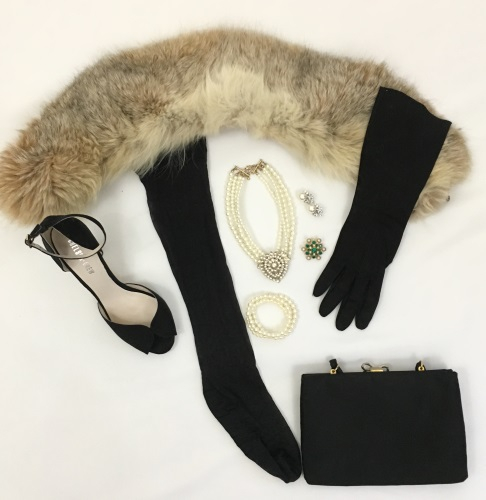
Here is a cheat sheet I put together- Feel free to share it with other event attendees who may need some guidance:
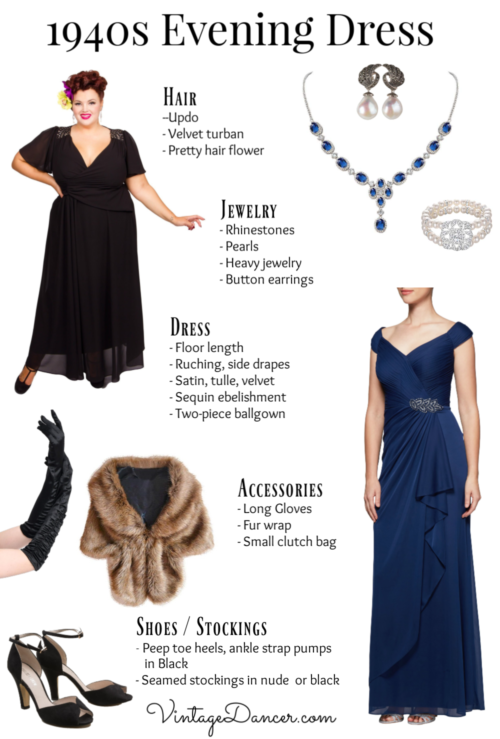
1940s evening dress plan- Hair, accessories jewelry and shoes
Patterns for a 1940s Formal Dresses
- Vintage Knitting Pattern to Make a 1940s Lace Evening Gown (Amazon.com)
- Simplicity 1940s Evening Dress pattern
- Eva Dress – 1944 dinner dress with jacket
- Vintage Vogue – Cocktail dress in satin. You can lengthen it for a long evening gown style
More 1940s patterns here.
1940s Style Formal Dresses
Prom season each year brings vintage lovin’ gals out shopping for a 1940s vintage or vintage inspired prom dress. Other than big puffy ballgowns that look more ’50s than ’40s to me, the selection is a bit limited. Most ’40s formal dresses had sleeves, while most modern gowns are sleeveless. Often, the best 1940s prom dress selection is either grouped with “modest” prom dresses or with “mother of the bride” formal dresses.
For semi-casual affairs and cocktail parties, the short cocktail dress is much more affordable and easier to find. I look for black or dark colored knee length dresses with a slender fit (not tight) in rich fabrics like taffeta, velvet, or heavy cotton blends. Sleeves are a must in any length. Modesty up top is also critical.
See some ’40s outfits I have put together here, including cocktail and formal dresses.
